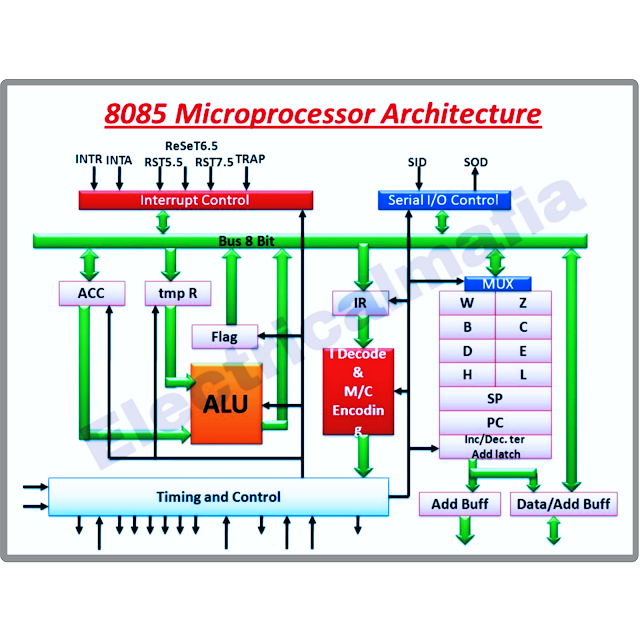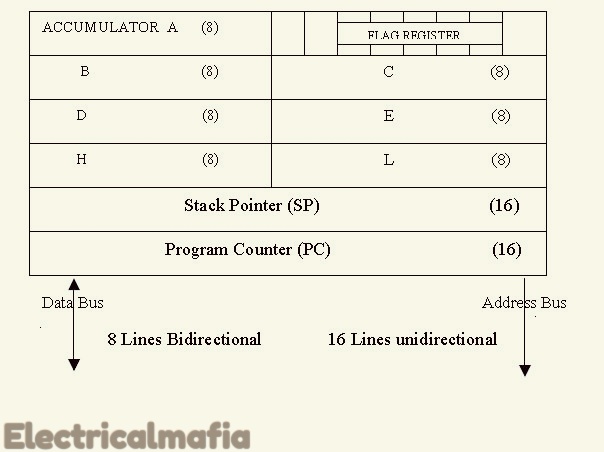Architecture of 8085 microprocessor
 |
| 8085 microprocessor architecture |
(A)Register structure:
The shaded portion of this register model is called programmer's model of 8085.
 |
| Register structure |
It includes six 8-bit registers -(B,C,D,E,H and L) one accumulator, one flag register and two 16-bit registers(SP and PC).All these registers are accessible to programmer and hence they are included in the programmer's model. The remaining registers-Temporary,W and z are note accessible to the Programmers;they are used by microprocessor for internal,intermediate operations.
Use of W and Z registers
That is a CALL instruction is used to transfer program control to a subprogram or subroutine.This instruction pushes the current PC contents onto the stack and loads the given address into the program counter.The address is temporarily stored in the W and Z registers and placed on,the bus for the fetch cycle. the program control is transferred to the address given in the instructional. XCHG instruction exchanges the contents of H with D and L with E. At this time of exchange W and Z registers are used for temporary storage of data.
1.General purpose registers:
B,C,D,E,H and L are 8-bit general purpose registers can be used as a separate 8-bit registers or as 16-bit register pairs,BC,DE and HL. HL pair is also functions as a memory pointer. or data pointer
2.Special purpose registers:
2.1) Register A(Accumulator): It is a tri-state eight bit register.It is extensively used in arithmetic,logic,load and store operations, as well'as in,input/output(I/0) operations.the result of arithmetic and logical operations is stored in register A. Hence it is also identified as accumulator.
2.2) Flag Register(Program status word): It is an 8-bit register,in which five of the bits carry significant information in the form of flags: S(Sign flag), Z(Zero flag), AC (Auxiliary Carry flag), P(Parity flag),and CY(Carry flag)
| D7 | D6 | D5 | D4 | D3 | D2 | D1 | D0 |
|---|---|---|---|---|---|---|---|
| S | Z | AC | P | CY |
S-Sign flag: After the execution of arithmetic or logical operations,if bit Dz of the result is 1,the sign flag is set.In a given byte if D-is 1,the number will be viewed as negative number.If D-is O,the number will be considered as positive number.
Z-Zero flag: This flag is sets if the result of operation in ALU is zero and the flag is resets if result is non zero.The zero flag is also set if an certain the register content becomes zero following increment or decrement operation of the register.
AC-Auxiliary Carry flag:This is set if there is overflow out of bit 3 i.e., carry from lower nibble to higher nibble(D3 bit to D4bit). This AC flag is used for BCD Operations and it is not available for the programmer.
P-Parity flag: Parity is defined by the number of ones present in the accumulator. Atter an arithmetic or logical operation if the result has an even number of ones, l.e.even parity,the flag is set.If the parity is odd,flag is reset.
CY-Carry flag:This flag is set if there is an overflow out of bit 7.The carry flag is that the serves as a borrow flag for subtraction.In both the examples shown below,the carry flag is set.
2.3) Instruction register: In a typical processor operation,the processor first fetches the opcode of instruction from memory (i.e. it places an address on the address bus and memory responds by placing the data stored at the specified address on the data bus). CPU stores this opcode in a register called the instruction register.This opcode is further sent to the instruction decoder to select one of the 256 alternatives.
2.4) Program Counter(PC): the Program is a sequence of instructions. As it is mentioned earlier,microprocessor fetches these instructions from the memory and executes them sequentially.The program counter is a special purpose register,which,at a given time, stores the address of the next instruction to be fetched.Since address of 8085 is 16-bit, the PC is 16-bit.Program Counter acts as a pointer to the next instruction.How processor increments program counter depends on the nature of the instruction;for one byte instruction it increments program counter by one, for two byte instruction it is increments program counter by two and three byte instruction it is increments program counter by three such that program counter always points to the address of the next instruction.
2.5)Stack Pointer(SP): This stack is a reserved area of the memory in the RAM where temporary information may be stored.A 16-bit stack pointer is used to hold the address of the most recent stack entry.
(B) Arithmetic Logic Unit(ALU)
The 8085's ALU performs arithmetic and logical functions on eight bit variables.The arithmetic unit performs bitwise fundamental arithmetic operations such as addition and subtraction.The logic unit performs logical operations such as complement, AND,OR and EX-OR, as well as and clear and rotate. The ALU also looks after the branching decisions.
(C) Instruction Decoder and Machine Cycle Encoder
The instruction decoder decodes the opcode and accordingly gives information to the timing and control circuit.
The microprocessor executes a seven different types of machine cycles.If a gives the information about which machine cycle is currently executing in the encoded form on the S0 S1,and IO/M lines.This task is done by machine cycle encoder.
(D) Address Buffer
That is a 8-bit unidirectional tristate buffer.It is used to drive external high order address bus(A15 -A8).
(E) Address/Data Buffer
This is an 8-bit bi-directional buffer.It is used to drive multiplexed address/data bus, i.e.low order address bus(A7-Ao) and data bus(D7-Do).
(F) Incrementer/Decrementer Address Latch:
This is a 16-bit register is used to increment or decrement the contents of program counter or stack pointer.
(G) Interrupt Control
That is the interrupt control block has five interrupt inputs RST 5.5, RST 6.5, RST 7.5, TRAP and INTR and one acknowledge signal INTA. It controls the interrupt activity of 8085 microprocessor.
(H) Serial I/O Control
The 8085 microprocessors serial I/O control provides two lines,SOD and SID for serial communication.The Serial Output Data(SOD)line is used to send data serially and Serial Input Data(SID)line is used to receive data serially.
(I) Timing and Control Circuitry
The control circuitry in the processor of 8085 microprocessor is responsible for all the operations.The control circuitry and hence the operations in 8085 are synchronized with the help of clock signal. Along with the control of fetching and decoding operations and generating appropriate signals for instruction execution,control circuitry also generates signals required to interface external devices to the processor of 8085.
(J) Instruction Execution and Data Flow in 8085
In order to execute program,the starting address of the program is loaded into the Program Counter(PC).
The 8085 sends the contents of PC as an address on the address bus and activates RD control signal.
Upon receiving the address and RD signal memory puts the contents of addressed memory location on the data bus which is an opcode of an instruction.
Meanwhile,PC is incremented to point the next memory location in the program sequence.
RD signal is deactivated and opcode is loaded into the instruction register via internal bus of microprocessor.
The instruction decoding unit decodes the instruction and provides information to the timing and control unit to generate necessary signals for instruction execution.






Nice article
ReplyDeleteWhat an amazing post related to microprocessor and which is related to the best electrician in Desoto where you can resolve all the things.
ReplyDeleteDYNALOG 8085 Microprocessor Programming Trainer Kit : DYNA 85 - Buy on Amazon
ReplyDeletehttps://www.amazon.in/dp/B07QQPMQ9J
High performance 8085A CPU @ 3 MHz with 4 K powerful monitor Firmware including all standard commands , codes , functions , utility subroutines
6 digit seven segment LED display , 46 parallel I/O lines - 22 from 8155 and 24 from 8255
Versatile Keyboard / Display controller using 8279 , Serial I/O through auto adjusting type RS-232 channel , specially designed 230 V AC , Switch Mode Power Supply
8085 Microprocessor good explaination
ReplyDelete